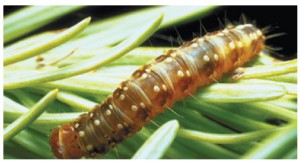
Anyone who has driven by car from Vancouver to Kelowna, which lies in the heart of the Okanagan Valley, will have witnessed the devastation first-hand: mile after endless mile of dying forests that are reddish-brown in colour, instead of the rich, dark, verdant green we normally associate with the forests of British Columbia.
Their silent killer is the tiny, almost invisible mountain pine beetle, which eats its way through the bark of the jack pine tree, one of the major species in the boreal forest that covers much of Canada, from the West Coast right across to Atlantic Canada.

Warmer winters, which have become the norm in recent years, are accelerating this trail of destruction. A sudden drop in temperature (20˚C) or sustained cold weather (-37˚C) will normally kill the beetle and its larvae, which has its own natural antifreeze for combatting the cold. But such cold temperatures, especially over a sustained period, are increasingly a rarity in the B.C. interior, and that is one reason the population of mountain pine beetles is no longer being held in check.
Other killers are also on the loose. The western spruce budworm has long been a threat to the forests of British Columbia, Alberta and western United States. The first recorded outbreak of this insect defoliator was on Vancouver Island at the beginning of the last century. Other infestations in the U.S. Pacific Northwest and the Rockies soon followed. The voracious budworm attacks many species, from the towering Douglas fir to the white spruce, the blue and white spruce, the western larch and all varieties of coniferous trees. It seems that nothing is off the menu for its unremitting appetite.
Fears of a New Brunswick infestation
Outbreaks of spruce budworm infestation were traditionally held in check by a combination of human interventions such as aerial spraying, controlled burning of forests, and “natural regulatory factors” such as parasites, vertebrate and invertebrate predators and cold weather. But warmer temperatures are contributing to the spread of budworm. In Eastern Canada, there has been a renewed outbreak in the lower St. Lawrence region of Quebec and there are fears it could spread into the forests of New Brunswick.
We should be concerned. Conifer trees are a key renewable resource and the mainstay of our forestry industry, which reaped $23.7 billion in revenues in 2011, or slightly greater than one percent of our total GDP.
Science, however, may be coming to the rescue. It is not the science of concocting new chemicals that can be sprayed on trees to kill these tiny predators. It is the new science of DNA sequencing and genomics, which is not only radically changing the world of medicine and how we understand and treat genetically based disorders such as cystic fibrosis, some forms of cancer and the like, but is also being applied to sequence the genomes of other animal and plant species, with potentially revolutionary consequences.
DNA comprises the inherited building codes of all living organisms. The Human Genome Project, which started in 1984 and completed its work in 2003, identified the three billion nucleotides that make up the genetic code for human beings. This incredible number of programming switches controlling different pathways, cells, tissues, organs and functions in the human body underscores our species’ inherent complexity.
Trees’ genome longer than humans’
But when scientists turned their attention to sequencing the genomes of flora and fauna, such as trees, they found an even greater complexity in their genetic composition. Last year, for example, an international group of researchers who had painstakingly been sequencing the genome of the Norway spruce tree — a species prevalent in Europe and North America — announced they had successfully sequenced its genome.
It was almost seven times longer than the human genome, with 20 billion base pairs in all. At the same time, the same team of Swedish and Canadian scientists also announced they had sequenced the white spruce genome, another one of the major species in the northern boreal forest. Scientists believe these are some of the longest genes in the plant kingdom.
Why is there such genetic complexity in those tall giants that are the lungs of the Earth? All genomes can be parsed into two components. First, there’s the DNA that carries the code for the construction of proteins, the central structural and functional units of the cell; this is called the coding region of the genome. The second component, making up the rest of the genome, is DNA that does not carry the protein information and thus is called the non-coding region. This second component, sometimes also called the genome’s dark matter, reflecting our lack of knowledge about its function, is by far the largest portion of the genome — in humans it represents 99 percent of the whole. This asymmetry is amplified in the Norway spruce, which, while having roughly the same size of the protein coding region as humans, has a full 10 times the size of our non-coding region.
The reason for this disproportion is somewhat prosaic. Sections of non-coding DNA called Long Terminal Repeats, which are normally winnowed from our own genomes, have not been in gymnosperms, (seed-producing plants) accumulating and leading to a “genomic obesity.” Buried within these are likely regulatory elements, which, among a host of other functions, confer the tree’s resistance to different kinds of infections. With time, the dissection of this new treasure trove of knowledge, in essence the operating manual for the Norway spruce, may offer up new and potent means of countering the pests that currently assail our forests.
Dr. Alex MacKenzie, former chief scientist at Genome Canada, now based at the Children’s Hospital of Eastern Ontario (CHEO) in Ottawa, says: “The gymnosperm was a real Everest; one of the largest, most technically challenging of the plant genomes. Its sequencing, which has taken place later than other less important, more tractable plant species, represents a technical tour de force.”
International research-sharing
Almost as exciting is the fact that Canadians, who have long been leaders in the field of medicine and the study of the human genome, are also at the forefront of this new research into the genetic make-up of key species in the boreal forest. The study on the white spruce genome was part of the SMarTForests Project, which is comprised of a team of researchers from the Genome Sciences Centre at the British Columbia Cancer Agency, the University of British Columbia, Simon Fraser University, Université Laval and the British Columbia Ministry of Forests, Lands and Natural Resource Operations. The study was funded by Genome Canada, Genome British Columbia and Génome Québec.
The team responsible for decoding the Norway spruce genome was led by scientists in Sweden and Canada, including Joerg Bohlmann from UBC’s Michael Smith Laboratories and John MacKay from Université Laval, who head the SMarTForests Project.
According to Marc Lepage, who heads Génome Québec: “The tree genome is extremely complex and it is beyond the scientific capabilities of a single country to analyse and sequence its basic genetic architecture. So we have joined our colleagues in Sweden, France, Brazil, the U.S. and many others and we are all sharing the load in building the basic knowledge we all need. Once we have done that, each country or region will be able to mine this massive database to better understand the specific tree species that are important to each: Black spruce in Quebec, white spruce in British Columbia, pine in Scandinavia, eucalyptus in Brazil, and so forth.”
Fen Osler Hampson is a Distinguished Fellow and Director of Global Security & Politics at the Centre for International Governance Innovation (CIGI) and concurrently Chancellor’s Professor at
Carleton University.




